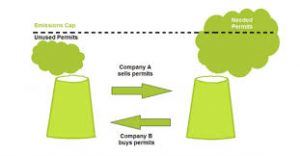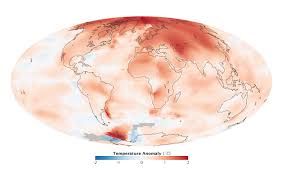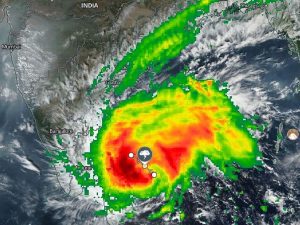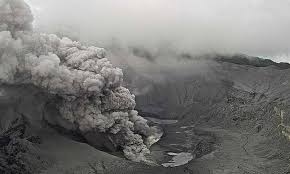Today’s Current Affairs: 24th April 2025 for UPSC IAS exams, State PSC exams, SSC CGL, State SSC, RRB, Railways, Banking Exam & IBPS, etc
Table of Contents
Emissions Trading Scheme (ETS):

The Surat Emissions Trading Scheme (ETS) is the world’s first market-based mechanism specifically designed to control particulate air pollution.
- An Emissions Trading Scheme (ETS) is a regulatory tool that aims to reduce air pollution by introducing economic incentives.
- Under ETS, a cap is imposed on the total permissible emissions.
Industries receive emission permits, which can be bought and sold, allowing companies to trade pollution rights. - This system is also referred to as “cap-and-trade”.
- Cleaner industries can sell their unused permits to polluting units, creating an economic incentive for pollution reduction.
- The Surat Emissions Trading Scheme (ETS) launched in 2019 is the world’s first ETS focused on trading particulate pollution (not CO₂), and India’s first emissions market for any pollutant.
- It targeted 342 high-emitting industries, mainly in the textile sector, which used solid fuels like coal and lignite, and liquid fuels like diesel.
- The scheme was developed by the Gujarat Pollution Control Board (GPCB) in collaboration with J-PAL, EPIC, and Yale University.
Cloudburst : Ramban District Of Jammu And Kashmir

The Ramban district of Jammu and Kashmir witnessed torrential rainfall and hail, resulting in severe damage.
- The India Meteorological Department (IMD) reported 9 mm of rainfall in 24 hours, marking a 575% increase from the normal 2.5 mm.
- A cloudburst is a localised and extremely intense rainfall event, defined by rainfall of 10 cm or more within one hour over an area of approximately 10 km × 10 km.
- Even 5 cm of rain in 30 minutes over the same area qualifies as a cloudburst.
- Cloudbursts are more common in mountainous regions due to a process known as orographic lift. In this phenomenon:
- Warm air ascends the mountain slope and expands due to lower atmospheric pressure at higher altitudes.
- As it expands and cools, the air releases its moisture in the form of precipitation.
- When large volumes of warm, moist air keep rising and accumulating moisture without releasing it, it can lead to a sudden, violent downpour.
- Because of their localised nature, cloudbursts are difficult to forecast and can overwhelm drainage systems, resulting in flash floods and landslides.
Arctic Amplification:

According to the 2024 European State of the Climate Report, Europe has warmed nearly twice as much as the global average, with far-reaching climatic and ecological consequences.
Key Highlights from the 2024 European State of the Climate Report:
- The global average temperature has risen by approximately 3°C above pre-industrial levels (1850–1900 baseline).
- In 2024, the planet crossed the critical 5°C threshold for the first time ever.
- Europe’s average temperature has increased by about 4°C, making it one of the fastest-warming regions on Earth.
- This accelerated warming has led to extreme weather events, including intense heatwaves, heavy rainfall, and flooding.
- Regional climatic contrasts within Europe:
- The Eastern part of Europe experienced warmer and sunnier
- Western Europe witnessed cloudier and wetter
- Southeastern European countries (e.g., Bulgaria, Romania, Serbia, Croatia) saw their longest heatwave on record in 2024.
- The number of ‘cold stress days’ was the lowest ever, and below-freezing temperature days dropped significantly.
- Arctic amplification is a phenomenon where temperature changes in the polar regions, especially the Arctic, are more intense than the global average temperature change.
- It is a form of polar amplification, which occurs when changes in Earth’s atmosphere lead to a greater rise in temperatures near the poles than in other parts of the world.
- This effect is measured against the average temperature rise of the planet and is particularly pronounced in the northern polar regions, hence the term Arctic amplification.
- The phenomenon is primarily driven by changes in the net radiation balance of the atmosphere, especially due to the increase in greenhouse gases like CO₂ and methane, which trap more heat in the Arctic region.
- The major contributing factors to Arctic amplification are: Ice-Albedo Feedback, Lapse Rate Feedback, Water Vapour Feedback & Ocean Heat Transport.
Quantum Gravity Gradiometer:

NASA scientists have proposed an innovative use of cold atom-based Quantum Gravity Gradiometers (QGGs) to measure how the Earth’s mass distribution is changing, especially due to climate change.
- NASA scientists propose placing a Quantum Gravity Gradiometer onboard a satellite to detect minute gravitational changes.
- In a QGG, atoms of a specific element are cooled to near absolute zero in a vacuum, transforming them into wave-like states.
- Lasers manipulate these atoms, and the atoms undergo a phase shift directly related to the gravitational force acting upon them.
- This setup can detect differences in acceleration as small as 10⁻¹⁵ m/s² over a distance of just 1 meter.
- This includes estimating the mass of large formations like the Himalayas and monitoring the movement of water, ice, and geological materials with extreme precision from low Earth orbit.
- The gravitational force experienced at different points on the Earth’s surface is not uniform; it depends on the mass of nearby objects.
- For instance, gravitational force near a mountain range is stronger than in less dense regions, like cities or flat plains.
- Gravity Gradiometer is a highly sensitive instrument that measures how gravitational acceleration changes from one place to another.
- For example, when a ball is dropped, the acceleration due to gravity can vary slightly depending on local mass differences.
- These devices are used in resource exploration—like locating hydrocarbon deposits, as oil and gas are less dense than surrounding rock.
Sunrise Industry:

Finance Minister Nirmala Sitharaman recently said India plans to increase the share of the manufacturing sector from 12% to 23% over the next two decades helped by sunrise sectors.
- Sunrise industry is a term frequently used for a sector that is developing and poised for rapid growth.
- Typically, such industries register high growth rates and have numerous start-ups and plenty of funding.
- Sunrise industry examples include the alternative energy industry highlighted in 2003 and 2007, the social media and cloud computing industries of 2011 and 2012, and blockchain industries established from 2013 to 2017.
- A sunrise industry often has a high degree of innovation, and its rapid emergence may threaten a competing industry sector already in decline.
- The competing industry sector is commonly referred to as a sunset industry.
- As an industry grows and matures, it may pass from the sunrise phase to maturity and, finally, the sunset stage.
- The compact-disc industry is an example of such a transition.
- It was a sunrise industry in the 1990s when compact discs replaced vinyl records and cassette tapes, but the rapid adoption of digital media in the 21st century saw the industry move into the sunset phase.
Jwaneng Diamond Mine:

The Jwaneng Diamond Mine is the richest diamond mine globally, with an estimated value of 1 billion euros.
- Jwaneng Diamond Mine, dubbed the ‘Prince of Mines,’ is located in Botswana.
- It is the world’s richest diamond mine by value.
- The mine lies on the edge of the Kalahari Desert.
- It is situated in an ancient volcanic crater about 170 km southwest of Botswana’s capital, Gaborone.
- The mine is operated by Debswana, a joint venture between De Beers, a leading diamond company, and the Botswana government.
- Jwaneng, which means “a place of gems” in Setswana, sits atop a kimberlite pipe, a volcanic formation that brings diamonds from deep within the Earth’s mantle to the surface.
- The mine’s history dates back to the 1970s when De Beers discovered the site, and it has been operating since 1982.
- Over the years, it has produced millions of carats of diamonds from its three main kimberlite pipes.
- In 2023 alone, Jwaneng produced 13.3 million carats, solidifying its reputation as the world’s richest diamond mine, valued at an estimated £1 billion.
- Jwaneng has played a crucial role in Botswana’s economy. It is estimated that the mine’s revenue has crossed $96 billion since its inception.
- Mining at Jwaneng is highly advanced, with large drills loosening the rock, and trucks transporting it to a processing plant.
- Here, diamonds are separated using state-of-the-art technologies like X-ray and laser sorters.
- Jwaneng was the first in Botswana to receive ISO 14001 certification for its eco-friendly practices.
Poas Volcano : Erupted Recently

The Poás volcano, one of Costa Rica’s most popular tourist attractions, erupted recently.
- Poás is one of Costa Rica’s most active volcanoes.
- The volcano is located within the Poas Volcano National Park.
- It is a composite stratovolcano with an irregular complex form and a basal area of about 400 sq.km.
- It rises to 2,708 metres above sea level.
- It has been formed from adjoining eruptive centres with large collapse craters.
- Its main crater is about 1.5 km wide and 300 meters deep—one of the largest active craters in the world.
- Since 1989, it has markedly increased the emission of gases causing acid rain phenomena that have damaged the flora in some sectors of the Park and surrounding agricultural plantations to the area.
- Throughout 2024, the volcano’s crater lake has been drying up, triggering ash-producing eruptions and releasing increased gas levels.
- Small explosions ejecting rocks have also occurred, and the drying process continues.
Exercise Desert Flag-10:
India participated in Exercise Desert Flag-10, a premier multinational air combat exercise hosted by the United Arab Emirates (UAE) Air Force.The exercise includes air forces from Australia, Bahrain, France, Germany, Qatar, Saudi Arabia, South Korea, Turkey, the UK, and the US.The exercise aims to enhance interoperability, operational synergy, and mutual understanding through complex air combat scenarios and exchange of global best practices. The Indian Air Force (IAF) deployed MiG-29 and Jaguar aircraft, showcasing its frontline combat capabilities.
Pahalgam Terror Attack:
A terror attack in Pahalgam, Anantnag (J&K) killed over 26 civilians, including tourists, making it the deadliest such attack since 2019. The strike coincided with PM Modi’s visit to Saudi Arabia and US Vice President JD Vance’s trip to India, signalling calculated geopolitical messaging.Terrorists ambushed a group of ~40 tourists at the popular Baisaran meadow using automatic rifles and small arms. Victims were identified by name (and likely religion) before being executed. Injured tourists were later evacuated by helicopter to Army hospitals.
PM10 Pollution in India:
A new four-year analysis by Respirer Living Sciences revealed that all 11 major Indian metro cities, including Delhi and Patna, exceeded PM10 safety limits continuously from 2021–2024, indicating chronic air pollution.PM10 refers to particulate matter with a diameter of 10 microns or less, capable of entering the respiratory tract. It includes dust, pollen, mold, and emissions from vehicles, industries, and construction activities. PM10 contains inorganic compounds, heavy metals, and biological material.
Includes both primary particles (directly emitted) and secondary particles (formed through chemical reactions in the air).
Sources include vehicular emissions, construction, industrial activities, stubble burning, and waste combustion.
Vatican City : In News
Vatican City is in global focus following the death of Pope Francis at the age of 88, prompting preparations for his funeral at St. Peter’s Basilica and the upcoming conclave to elect his successor.Vatican City Situated in Western part of Rome, Italy (on the west bank of the Tiber River.) Surrounded by: Rome (Italy). It is an enclave with no borders with any other country. Population: Approx. 882 (2024 estimate) – Least populous sovereign state. Capital: Vatican City (same as country name – a city-state).
Form of Government: Ecclesiastical absolute monarchy under the Pope. Administered by: The Holy See, headed by the Pope (Bishop of Rome), who holds executive, legislative, and judicial powers.
Humanoid Robots Compete in Beijing Half-Marathon:
Beijing witnessed a historic event the world’s first Humanoid Robot Half-Marathon, where machines ran alongside humans in a symbolic convergence of sport and technology. Held under global media glare, the event showcased the significant strides being made in humanoid robotics and artificial intelligence. While human runners stuck to standard race norms, the robot participants followed specially adapted rules with engineering support. Despite mechanical missteps and frequent pit stops, the event sparked intense curiosity, optimism, and debate around the future role of robots in society.
RBI Eases LCR Norms, Imposes 2.5% Additional Run-Off Factor on Digital Deposits:
The Reserve Bank of India (RBI) has introduced significant amendments to its Liquidity Coverage Ratio (LCR) framework with the objective of enhancing liquidity risk management among commercial banks while aligning domestic norms with global standards. One of the key changes is the imposition of a 2.5% additional run-off factor on retail deposits that are enabled with digital banking facilities.
India Cuts Ties with Pakistan: Treaty Ended, Borders Sealed, Diplomats Expelled:
India has taken an unprecedented step by terminating the Indus Water Treaty (IWT) with Pakistan, a move that signifies the most serious breakdown in diplomatic relations between the two nations in recent years. Alongside the treaty’s termination, the Atari-Wagah border has been sealed, visa services for Pakistani citizens suspended, and defence advisors from both countries have been withdrawn. These actions reflect a decisive strategic shift in India’s foreign policy approach toward its western neighbour.
1% TCS on Luxury Goods Over ₹10 Lakh:
India has taken an unprecedented step by terminating the Indus Water Treaty (IWT) with Pakistan, a move that signifies the most serious breakdown in diplomatic relations between the two nations in recent years. Alongside the treaty’s termination, the Atari-Wagah border has been sealed, visa services for Pakistani citizens suspended, and defence advisors from both countries have been withdrawn. These actions reflect a decisive strategic shift in India’s foreign policy approach toward its western neighbour
India’s Largest Cruise Terminal Mumbai International Cruise Terminal (MICT) Begins Operations:
India’s largest cruise terminal, the Mumbai International Cruise Terminal (MICT), officially began operations. Inaugurated by Union Minister for Ports, Shipping, and Waterways Sarbananda Sonowal, the MICT marks a significant boost to India’s cruise tourism and maritime infrastructure. Designed to cater to 1 million passengers annually and five ships simultaneously, this Rs 556 crore terminal is a pivotal development in India’s vision to become a global maritime hub. Additionally, major infrastructure investment agreements exceeding Rs 5,700 crores were signed for Vadhavan Port, including container, bulk, and liquid cargo terminals.
‘Garia and Borsho Boron Utsav’ in Agartala Inaugurated By Manik Saha:
Tripura’s Chief Minister, Manik Saha, inaugurated the ‘Garia and Borsho Boron Utsav 2025’ in Agartala, a two-day cultural festival being held at the Swami Vivekananda Maidan. Organized by the Department of Information and Cultural Affairs, with support from various local bodies including the Tribal Welfare Department, the event aims to celebrate the region’s cultural heritage. The festival highlights the Garia Puja, an important religious celebration for the Tripuri and Reang communities, and features vibrant performances, traditional food stalls, and cultural exhibitions. The inauguration also saw the presence of various distinguished guests, underscoring the significance of this celebration for the indigenous people of Tripura.
Priyanka Chopra, Ang Lee, Megan Thee Stallion to Be Honoured at 4th Annual Gold House Gold Gala:
The prestigious Gold House Gold Gala returns for its 4th annual celebration on May 10, 2025, at the Music Centre in Downtown Los Angeles. This year’s star-studded event will honor prominent global figures including Priyanka Chopra, Jon M. Chu, Megan Thee Stallion, and Ang Lee for their cultural impact and groundbreaking achievements. The event, expected to host over 600 influential guests, also commemorates the forthcoming 2025 A100 List, recognizing the top 100 Asian Pacific changemakers in global culture. The theme for this year’s gala, “First Light,” emphasizes trailblazers who have paved the way for future generations. Priyanka Chopra will receive the inaugural Global Vanguard Honor for her exceptional career that bridges Bollywood and Hollywood while championing underrepresented voices.
Maharashtra Governor Presents Yashraj Bharti Samman Awards 2025:
Maharashtra Governor C.P. Radhakrishnan conferred the 3rd edition of the ‘Yashraj Bharti Samman’ awards to three notable grassroots-level organizations for their exemplary contributions in the fields of healthcare, education for sustainable development, and governance. The award ceremony, held in Mumbai, recognized the impact of Jan Swasthya Sahayog (Chhattisgarh), Pratham Education Foundation, and the Services Plus platform developed by the National Informatics Centre. The event witnessed the presence of dignitaries such as former Maharashtra Assembly Speaker Dilip Walse Patil and India’s G-20 Sherpa Amitabh Kant.




